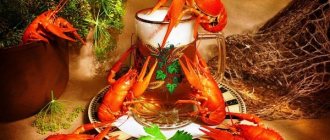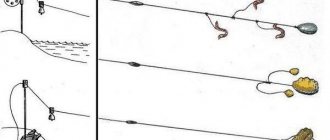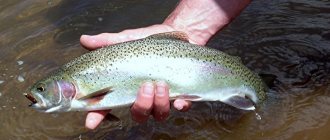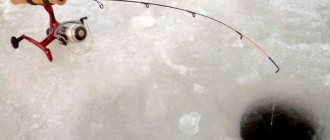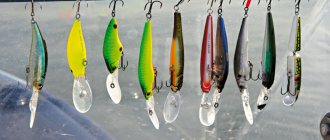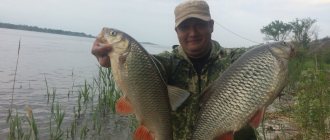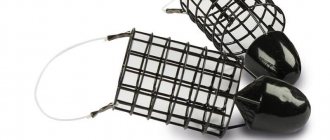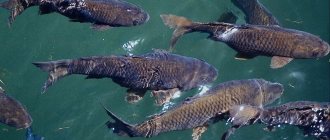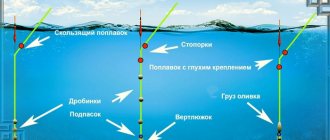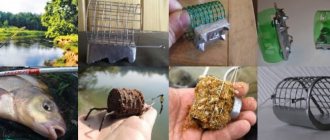Fishing using this method involves using a special open feeder, onto which thick sticky bait is stuck; only one hook is placed. To press the bait, the method uses special molds that compact the bait so that the bait does not fall out of the feeder when falling on the water. Read more about fishing using the method, equipment and bait.
Feeder Feeders Method
The basis of the “Method” feeder design is a lattice or frame with a certain weighting material. A special bait mixture is placed between the ribs, which serves as bait. Directly inside the feeder or next to it there is a short leash, to the end of which a hook with bait is tied.
Feeders of this type are used primarily in sport fishing for carp, as well as in feeder fishing for white fish.
The presence of self-cutting feeders allows you to comfortably fish with several rods at the same time. When using “method” feeders, there is no need to heavily feed the fish, since both the bait and the hook with bait will be delivered to the right place at the same time. Naturally, additional bait is necessary, but it will be required less than with conventional feeder fishing.
The displacement of the center of gravity of feeders of this type ensures that their heavy side falls towards the bottom, and the bait mixture along with the bait will in any case be on top, that is, accessible to the fish. Note also that “method” feeders are used mainly in reservoirs with weak currents or no current at all.
Feeders of the "Method" type
The method feeder is filled with feed manually using the hand pressing method, the volume of feed exceeds the size of the feeder
Feeders received the name “Method” from European countries, where they are actively used by carp fishermen, and all the gear partly even ceases to be called feeder and the direction of fishing takes the form of Carp Fishing (hunting for trophy carp).
“Method” is a prototype of the most common traditional domestic feeders – spiral feeders. But the difference is that in the Method feeder, high-viscosity feed is often filled only on one working side, while the spiral feeder does not have one working side at all. And here it is worth noting that “Method” type feeders also have different shapes.
All types of feeders "Method"
- A one-sided feeder always falls with the lead side on the ground, this allows carp and other trophies to freely eat the food with which the feeder is filled. Also, this particular feeder buries itself in the mud less than others.
- It is also one-sided and also always falls with the lead side on the ground.
- Multi-sided, falls on the ground as shown in the picture.
- Feeder in the form of a lead platform and a spiral. Rarely used by fishermen.
Feeder equipment Method
The feeder is filled with bait manually or using a special form. The bait is placed in the bait mixture itself. The latter can be attached directly to the hook or to a hair mount. If a blind installation is used, then the fish that grabs the bait is immediately affected by the weight of the feeder, which is why self-hooking occurs.
When using a sliding rig, the fish practically does not feel the resistance of the feeder, and therefore self-hooking will occur only after the fish begins to swim away with the bait.
Feed mixture for method feeder
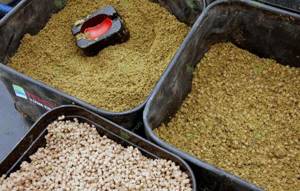
A special bait mixture for method feeders is not uncommon in fishing stores.
You can make your own mixture, fulfilling the requirement - the mixture must be sticky enough to remain in water for at least 15 minutes, and at the same time loose enough to quickly form a bait cloud.
This is usually achieved by applying the mixture in two layers.
The first layer (1/3 of the volume) is a wet layer of increased stickiness, with a high content of fish meal.
The second (2/3 of the volume) is a relatively dry layer that quickly disintegrates when the feeder reaches the bottom of the reservoir, but can be formed into a ball under the action of a mold.
The options for making your own mixture are endless, but you should consider:
- Fishmeal increases stickiness.
- Nozzle elements should be added to the mixture.
- Be sure to use aromatic ingredients.
The most attractive scents:
- toasted sunflower seeds, ground in a coffee grinder;
- crushed hemp seeds;
- molasses;
- dog or cat food.
Often the following are added to the mixture: ground pellets; milk formulas; custards; corn flour...
Blind equipment
This equipment option is used when hunting active fish using match or multi-sided “method” feeders. Both the end of the main line and the leash with the hook are attached to the feeder using small swivels, and are securely fixed with special cone-shaped rubber shock absorbers. The length of the leash , as a rule, does not exceed 10 cm.
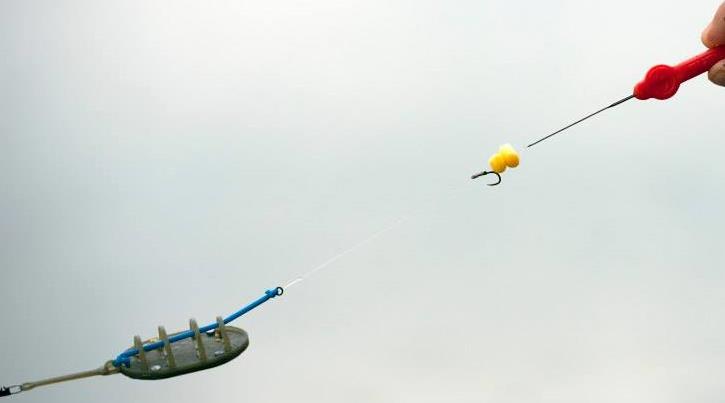
Sliding equipment (In-Line)
“Method” feeders with sliding equipment are used primarily for catching carp or other fish that are too cautious or not very active. With this rigging option, the main line is pulled through the entire axial cavity of the feeder, and then a small rubber bead is placed on it and a swivel is tied. A small leash is attached to the other end of this swivel, the length of which also does not exceed 10 cm.
If you intend to catch carp using the Method, a regular monofilament line with a diameter of about 0.3 mm and a breaking load of 3.5 kg is quite suitable. The line for the leash must be less strong than the main one.
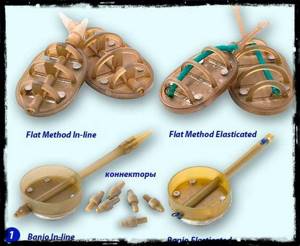
Equipment method installation methods
Blind installation of equipment
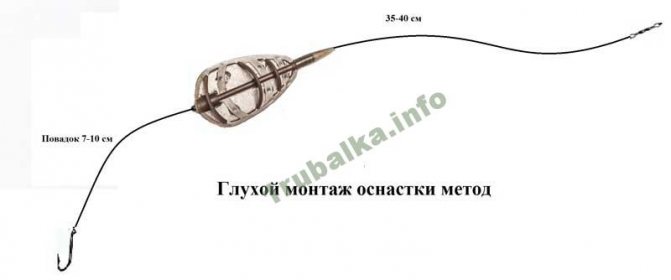
Blind installation of equipment method
Self-cutting mounting method, great for fishing with several rods. When biting, the fish makes a jerk and is caught under the weight of the feeder. As a base, we take a fishing line 0.25-0.35 mm thick, depending on the trophy, and thread it through the body of the feeder. Then at the extended end we make a small loop using a figure eight knot. In order for the knot to tighten better, we wet it. Then we thread the connector through the fishing line and attach the swivel using the noose loop. Then we pull the connector onto the swivel. Now we pull the fishing line so that our swivel and connector fit firmly into the body of the feeder. A leash 7-10 cm long is attached to the swivel.
We retreat 35-40 cm from the feeder and knit a figure eight loop; using a noose, we attach a swivel to it. It will connect our rig to the main line.
When installing equipment, some athletes use leadcore instead of monofilament - a braided cord with a lead core inside. Thanks to this, your equipment is not so prone to twisting, is perfectly sunk on the bottom and does not scare the prey, causing less injury to the fish.
Feeder equipment inline method
Sliding equipment (inline) is used for catching cautious fish, as well as on days when they are inactive, because when the fish bites there is no need to move the feeder.
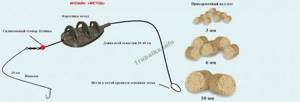
Inline method
To mount this gear, we use a monofilament fishing line of the same diameter as for the blind one, the length of the entire equipment is about 40 cm. We knit a swivel to the edge of the fishing line, and then the main fishing line will be knitted to it. then we thread a bead or silicone stopper through the opposite end; their task is to prevent the knot from hitting the feeder. After we thread the feeder, again we pass a bead or stopper and knit a swivel, the bead and stopper are selected with such a diameter so that they sit tightly on the fishing line and do not wander. The rubber stopper can be pulled onto the swivel. In this case, the size of the bead or stopper should not allow the swivel to enter the body of the feeder. Then we knit a leash 7-10 cm long to the swivel. The difference from the blind installation is that the equipment will slide freely along the fishing line.
Carp rig method for feeder
Here we will use flat-method feeders with feeder rubber ; you can buy them with rubber already installed on the feeder, or you can do it yourself.

Method-on-carp
Feeder Gum or Power gum is used for these purposes. We take an elastic band and attach a swivel to one edge using a figure eight knot, then thread the cambric and pull it onto the knot. Then we measure out the segment, as shown in the figure, the rubber at this moment should not be stretched, then we cut off the excess, skip the feeder and knit a swivel. If you did everything correctly, your feeder rubber will not protrude from the body of the feeder. Then, on the side where we have the cambric, we knit a leash 7-12 cm long, and on the opposite side, we knit the main line.
If there is no rubber, then install a 10 m shock leader made of monofilament with a diameter of 0.4 mm. The main line is also a monk 0.25-0.3 mm (we also use the same diameter when fishing with rubber). Then you do a dead-on or in-line installation. The thickness of the leash is 0.02 mm less than the diameter of the main line. When fishing for carp, it is recommended to use hair bait.
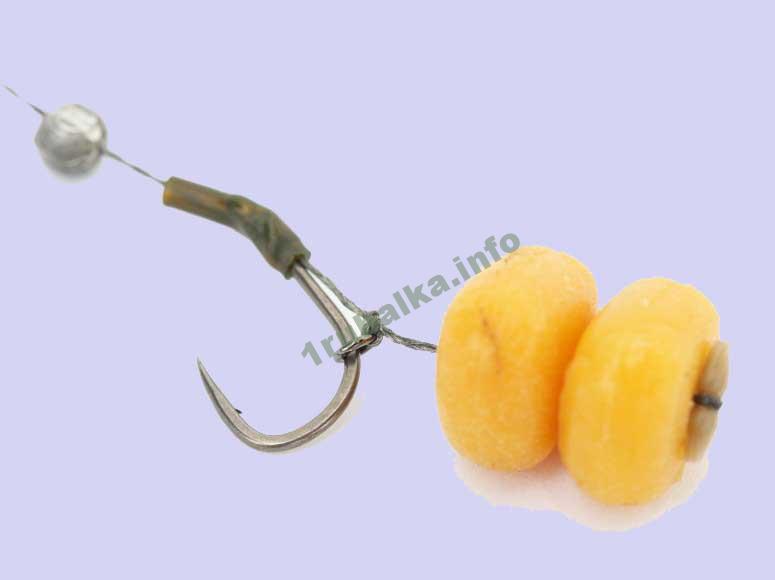
Hooks No. 12 - No. 16 according to the international classification.
Feeder shapes Method
Banjo models are convenient and simple, but if you cast such feeders too hard, there is a chance that the bait will simply fly out. Flat Method feeders have a more complex design with special arches that better hold the bait. Products of both model categories can be made in two versions:
- In-line feeders, which involve the use of sliding installation;
- Elasticated feeders designed for flush mounting.
Models for sliding equipment have greater sensitivity and are suitable primarily for catching medium-sized white fish. Elasticated feeders are designed for solid installation. When using them, a bite is felt only when the feeder moves from its place, and such models are designed more specifically for self-hooking.
Feeders for blind rigs have a special rubber shock absorber that perfectly dampens sudden jerks during fishing. It is important to systematically check its condition so that one day an unfortunate break does not occur.
Korda Bait-Up Method Feeder
Feeders "Korda Bait-Up Method Feeder" - fully comply with the requirements for products of this type, their only drawback is the high price, especially compared to domestic feeders.
But in this case, it is better to buy a quality product that will fully work out its cost. Korda Bait-Up Method Feeder feeders are made of durable swamp-colored plastic with a rough surface, and they “hold” any type of bait without problems.
Characteristics of Kord method feeders:
- height with boot – 180 mm;
- height without boot – 155 mm;
- width – 40 mm;
- sole width – 15 mm;
- weights - 14, 28, 42, 56, 83 grams.
The feeder is made of plastic with a painted lead weight on one of the ribs; it is completely removable and hardly noticeable in the water. Mini method - 14, 28 grams, regular feeders - 42, 56, 83 grams.
In the latest collection, developers from Kord offered new, completely metal, painted methods, medium size and in weight of 35 and 50 grams.
But it is worth recognizing that the updated version is worse , and for several reasons:
- the bait sticks worse to the metal frame and is washed out faster in the water;
- the paint peels off quickly, and it becomes even more difficult to stick bait to the frame;
- the average size of the feeder is more convenient when fishing at short distances, but it is difficult to cast it over a long distance;
- The cornice at the bottom is smaller in diameter than it was in the first option, and this also affects the quality of bait retention.
New methods from Korda, of course, have found their fans, but the previous version is still much more convenient to use.
Carp fishing method
When fishing for carp using the “Method”, the correct selection of bait, finding a good place and a lot of patience play an important role. Having cast the tackle, it is very advisable not to touch the rod at all until the bite, so as not to create vibrations that are transmitted along the fishing line and scare away large fish.
When choosing a casting location, pay attention to the level of activity of the fish in different areas. Throw it where the presence of a large variety of fish is clearly visible. The frequency of recharging the feeder also depends on the degree of activity of the fish.
Large carp pays attention to the smell, the color, and the very content of the bait, so the latter should have a natural color and be very nutritious. You can use corn, worms, boilies and other baits as bait. Using dips when fishing using the method will also not be superfluous.
Bait recipes for the “Method” rig
Recipe No. 1
You will need:
- bread crumb (3 parts);
- finely chopped peanuts (1 part);
- cake (2 parts);
- honey (2 tablespoons);
- glass of dark beer.
These ingredients are mixed, gradually adding the required amount of water. The result is a homogeneous mass, similar in properties to clay or plasticine.
Recipe No. 2
Ingredients:
- grated rye and wheat bread (2 parts each);
- cottage cheese (1 part);
- cake (1 part);
- finely chopped peas (1 part);
- garlic juice (alternatively dill)
- hemp oil.
The cooking principle is identical to the previous one. The use of this bait will be more relevant in the spring.
Bait and bait
The bait is made quite viscous and dense, but at the same time it must disintegrate well on the bottom, otherwise it will lie in a lump on the bottom, not arousing interest. As a guide, the bait should completely empty the feeder after 15 minutes. You can achieve the required viscosity by moistening the bait (if you don’t add enough water, it’s loose; if you overfill, it’s viscous), adding water portionwise. You shouldn’t soak all the bait at once, leave a little so that you can make adjustments. If you fish with a nipple, then your bait should become a homogeneous mass, with properties reminiscent of wet clay (effective for catching large fish in wild reservoirs where there is a lot of small fish). In this case, do not forget to add flavorings and attractants to the bait, because such bait is visually less noticeable, since it does not generate dust and has a small food stain. Due to the fact that the feeder is open, it is very convenient to use flavoring sprays, especially if you have several types.

You can buy specialized method bait in the store, buy regular bait for white fish and add an adhesive component (for example molasses) or make it yourself. Here are some interesting recipes:
Recipe No. 1
- Pounded wheat bread – 300 grams;
- Cottage cheese 150 grams;
- Cake 150 grams
- Finely ground peas – 150 grams;
- Ground garlic;
- Hemp oil.
Recipe No. 2
- Breadcrumbs - 1000 grams;
- Corn flour 200 grams;
- Semolina 300 grams;
- Ground seeds 100 grams;
- Hemp 100 grams;
- Wheat bran 100 grams;
- Powdered milk 15-20 grams.
When fishing with a rig method, there is no need to do a massive starting feeding; 4-5 casts of the feeder are enough. Re-throw the feeder no more often, once every 15 minutes.
When fishing with a rig method, it is better if you use a large bait: a bunch of worms or maggots, corn, peas, various boilies, “ottomans”, soft pellets. In this case, pellets are often added to the bait itself.
